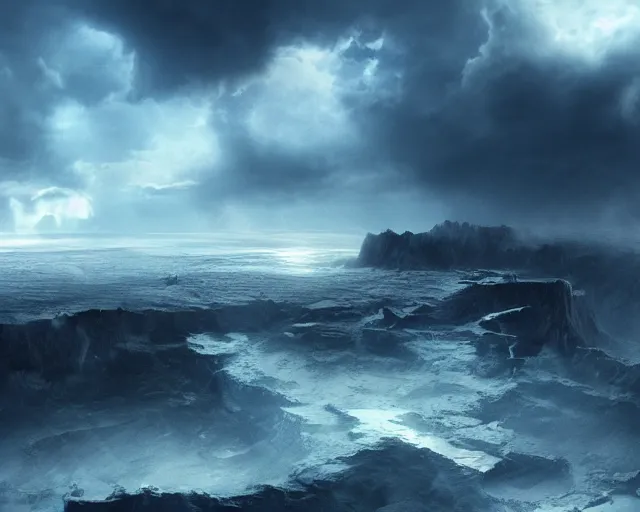Thalassia
Thalassia is not a continent in the traditional sense—it is a scar. A drowned shelf of broken crust and sunken stone, where tectonic memory and celestial judgment converge. Once a living continent in the northern tropics, Thalassia stood at the very heart of Sitagus. It was not merely central in geography, but central in origin. For it was here, on dry land, beneath what is now an endless tide, that Signus delivered his final blow—and where the gods tore the world upward to seal him in orbit.
The Moon of Signus—cold, watching, and heavy—was formed from the skin of this land. Torn from the crust in divine retaliation, the matter of Thalassia was lifted by force and forged in gravitational ritual, creating the tomb that now darkens the sky. In the wake of that celestial rending, the crust below collapsed inward. The mantle groaned and folded. Thalassia did not sink—it was hollowed, like a vessel that could no longer hold its shape. What remains is not land, but a submerged grave, where the bones of cities and the breath of gods still shift beneath the waves.
Today, only 1% of Thalassia's surface breaks above sea level—scattered coral atolls, weatherbeaten island arcs, and spiraled volcanic peaks that form salt-scabbed archipelagos. But beneath the surface lies an immense, shallow, drowned continent—6–8% of Sitagus’s total planetary crust—a place where ruined capitals lie beneath coral reefs, where seamounts glow with bioluminescent psalms, and where tides run strange and currents follow the memory of motion more than the logic of physics.
The region is known for its tidal amplification, driven by the unnaturally precise lunar pull of Disruk, the first and darkest moon. Where other moons wander, Disruk remains locked—eternally facing Thalassia, as if drawn to the wound that birthed it. The tides here are not just lunar—they are resonant, soul-reactive, and unstable. Water rises not only with gravity, but with grief. Storms coil in perfect spirals and vanish without warning. Some sailors swear they’ve seen the moon’s reflection move while the water lies still. Others believe Disruk listens—or hungers.
Despite its ruin, Thalassia is not uninhabited. In the tangled coral forests and drowned temple spires, entire aquatic civilizations thrive. The Shallow Empire of the Tritons rules over vast lagoons and sub-surface canals, their cities built atop vaulted terraces of pearl-stone and soul-glass. Aquatic Elves—quiet and reclusive—dwell deeper still, their culture bound to memory and tidal rhythm, preserving sunken libraries sealed by shimmering pressure wards. Merfolk kingdoms, mobile and mercantile, travel in living fleets of coral-shelled beasts. Sahuagin raiders, drawn by blood and the thrum of divine decay, rise from abyssal trenches to pillage and sacrifice to the drowned god they believe still stirs below.
Many of the islands that remain above water are enchanted with coral-mage growth, shaped by biomancers who coax reef and limestone into lattice towers, spiral piers, and breathable sanctuaries for land-bound traders and pilgrims. Trade exists—but it is watched. Surface vessels are only tolerated so long as they respect the tidal pacts and do not trespass into forbidden waters.
And there are forbidden places.
At the heart of the basin lies the Receding Pulse Zone—a still-sinking trench where gravity unravels, light bends sideways, and no divination spell can return an answer. It is here, scholars say, that the final blow landed. Where the crust was lifted. Where Disruk was born. The Seal of Signus is deepest here—though some say it is also thinnest. Instruments fail. Magic unravels. Time slows or doubles back. There are ruins here no cartographer can keep mapped, and wrecks that surface, untouched by time, then vanish again with the tide.
No surface nation claims Thalassia. No empire holds it. It is not land. It is loss, suspended in water, watched forever by the moon that remembers its name.
“We fish in the bones of gods and sail over cities we cannot name. And when the tide is right—we remember.”
— Yshavi kel-Na, salt-priest of the Atoll Temple


Comments